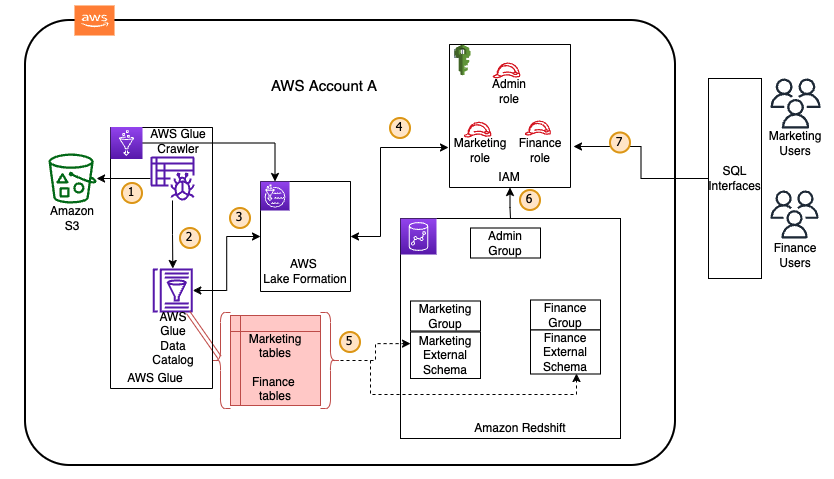AWS Big Data Blog
Category: Amazon Redshift
Perform ETL operations using Amazon Redshift RSQL
Amazon Redshift is a fast, scalable, secure, and fully managed cloud data warehouse that makes it simple and cost-effective to analyze all your data using standard SQL and your existing ETL (extract, transform, and load), business intelligence (BI), and reporting tools. Tens of thousands of customers use Amazon Redshift to process exabytes of data per […]
ETL orchestration using the Amazon Redshift Data API and AWS Step Functions with AWS SDK integration
Extract, transform, and load (ETL) serverless orchestration architecture applications are becoming popular with many customers. These applications offers greater extensibility and simplicity, making it easier to maintain and simplify ETL pipelines. A primary benefit of this architecture is that we simplify an existing ETL pipeline with AWS Step Functions and directly call the Amazon Redshift […]
Export JSON data to Amazon S3 using Amazon Redshift UNLOAD
Amazon Redshift is a fast, scalable, secure, and fully managed cloud data warehouse that makes it simple and cost-effective to analyze all your data using standard SQL. Amazon Redshift offers up to three times better price performance than any other cloud data warehouse. Tens of thousands of customers use Amazon Redshift to process exabytes of […]
Amazon Redshift at AWS re:Invent 2021 recap
The annual AWS re:Invent learning conference is an exciting time full of new product and program launches. At the first re:Invent conference in 2012, AWS announced Amazon Redshift. Since then, tens of thousands of customers have started using Amazon Redshift as their preferred cloud data warehouse. At re:Invent 2021, AWS announced several new Amazon Redshift […]
Build a REST API to enable data consumption from Amazon Redshift
API (Application Programming Interface) is a design pattern used to expose a platform or application to another party. APIs enable programs and applications to communicate with platforms and services, and can be designed to use REST (REpresentational State Transfer) as a software architecture style. APIs in OLTP (online transaction processing) are called frequently (tens to […]
How ENGIE scales their data ingestion pipelines using Amazon MWAA
ENGIE—one of the largest utility providers in France and a global player in the zero-carbon energy transition—produces, transports, and deals electricity, gas, and energy services. With 160,000 employees worldwide, ENGIE is a decentralized organization and operates 25 business units with a high level of delegation and empowerment. ENGIE’s decentralized global customer base had accumulated lots […]
Build a modern data architecture on AWS with Amazon AppFlow, AWS Lake Formation, and Amazon Redshift: Part 2
In Part 1 of this post, we provided a solution to build the sourcing, orchestration, and transformation of data from multiple source systems, including Salesforce, SAP, and Oracle, into a managed modern data platform. Roche partnered with AWS Professional Services to build out this fully automated and scalable platform to provide the foundation for their […]
Best practices to optimize your Amazon Redshift and MicroStrategy deployment
This is a guest blog post co-written by Amit Nayak at Microstrategy. In their own words, “MicroStrategy is the largest independent publicly traded business intelligence (BI) company, with the leading enterprise analytics platform. Our vision is to enable Intelligence Everywhere. MicroStrategy provides modern analytics on an open, comprehensive enterprise platform used by many of the […]
Centralize governance for your data lake using AWS Lake Formation while enabling a modern data architecture with Amazon Redshift Spectrum
Many customers are modernizing their data architecture using Amazon Redshift to enable access to all their data from a central data location. They are looking for a simpler, scalable, and centralized way to define and enforce access policies on their data lakes on Amazon Simple Storage Service (Amazon S3). They want access policies to allow […]
Define error handling for Amazon Redshift Spectrum data
Amazon Redshift is a fully managed, petabyte-scale data warehouse service in the cloud. Amazon Redshift Spectrum allows you to query open format data directly from the Amazon Simple Storage Service (Amazon S3) data lake without having to load the data into Amazon Redshift tables. With Redshift Spectrum, you can query open file formats such as […]






